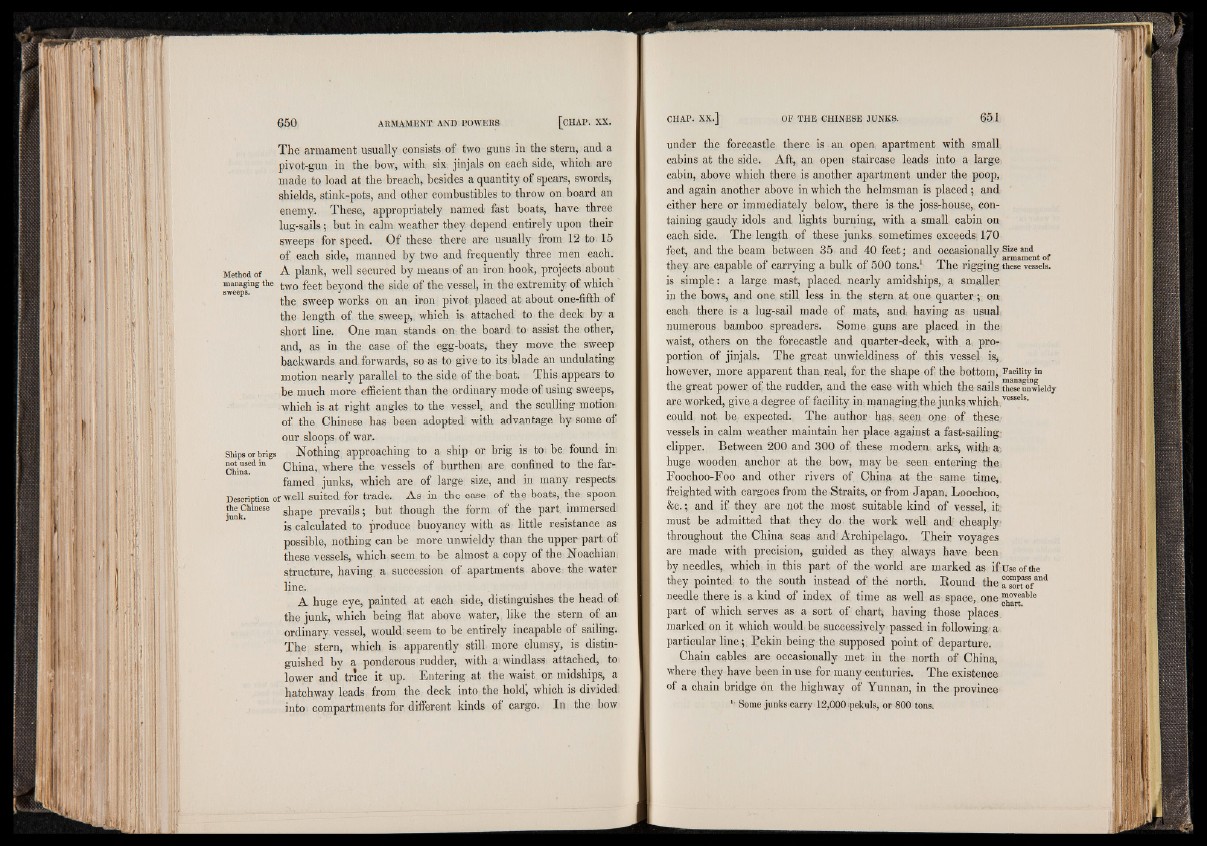
The armament usually consists of two guns in the stern, and a
pivot-gun in the bow, with six jinjals on each side, which: are
made to load at the breach, besides a quantity of spears, swords,
shields, stink-pots, and other combustibles to throw on board an
enemy. These, appropriately named fast boats, have three
lug-sails; but in calm weather they, depend entirely upon their
sweeps for speed. Of these there are usually from 12 to. 15
of each side, manned by two and frequently three men each.
Method of A plank, well secured by means of an iron hook, projects about
managing the tw0 feei; Wond the side of the vessel, in the extremity of which
sweeps. ' . . , ¿»jai the sweep works on an iron pivot, placed at about one-fiitn ot
the length of the sweep, which is attached to. the deck by, a
short line. One man stands on the board to assist the other,
and, as in the case of the egg-boats, they move the sweep
backwards and forwards, so as to give to its blade an undulating
motion nearly parallel to the side of the boat. Thisiappears to
be much more efficient than the ordinary mode of using sweeps,
which is at right angles to the vessel; and the sculling motion
of the Chinese has been adopted; with advantage by some of
our sloops of war.
Ships or trig s Nothing approaching to a ship or brig is to; be. found in;
ChiiTd China,, where the vessels of burthen; are. confined to the. far-
famed junks, which are of large; size, and in many respects
D e s c r i p t i o n o f well suited for trade. As in the case of th e boats, , the spoon
^ C h in e s e spape prevails; but though the form of the part, immersed;
is calculated to produce buoyancy with as little resistance as
possible, nothing can be more unwieldy than the upper part of
these vessels, which seem to be almost a copy of the;Noachian,
structure, having a succession of apartments, above: the water
line.A
huge eye, painted at each side, distinguishes the head of
the junk, which being flat above water, like the stern of an
ordinary vessel, would; seem to be entirely incapable of sailing.
The stern, which is apparently still more clumsy; is distinguished
by a ponderous rudder, with a, windlass attached, to
lower and trice it up. Entering at the waist or midships, a
hatchway leads from the deck into the hold', which is divided:
into compartments for different kinds of cargo. In the bow
under the forecastle: there is-an open apartment with small
cabins at the side. Aft, an open staircase leads into a large,
cabin, above which there is another apartment under the poop,
and again another above in which the helmsman is placed ; and
either here or immediately below, there is the joss-house,, containing
gaudy idols and lights burning, with a small cabin on
each side.. The length of these junks sometimes exceeds; 170
feet, and the beam between 35. and 40 feet; and occasionally sizeand „
n they are capable of carry•i ng a ibnulk of/.> 500 tons.i rinh e r•i ggi• ng armament of these vessels,
is simple : a large mast, placed nearly amidships,, a smaller
in the bows, and one. still less in the stern at one; quarter on
eadi there is a lug-sail made of mats, and haying as usual
numerous bamboo spreaders. Some gups are placed, in the:
waist, others on the forecastle and quarter-deck, with, a, proportion
of jinjals. The great unwieldiness of this vessel is,
however, more apparent than real, for the shape of the bottom, Facility in
the great power of the rudder,, and the ease with which the sails Seæunwieidy
are worked, give a degree of facility in managing.the junks which vessels-
could, not be expected., The author has, seen one of these;
vessels in calm weather maintain her place against a fast-sailing,
clipper. Between 200 and 300 of these modern arks, with, a-,
huge wooden anchor at the bow, may be seen entering the
Eoochoo-Foo and other rivers of China at the same; time,,
freighted with cargoes from the Straits, or from Japan, Lpochoo,
&c. ; and if they are not the most suitable kind of vessel,, it;
must be admitted that they do the work well; and; cheaply*
throughout the China seas and! Archipelago, Their voyages
are made with precision, guided as they always have been
by needles, which: in this part of the world are marked as if Use of the
they pointed to the south instead of thé north. Bound, the “ ”^tarfand
needle there is a kind of index of time as well as space, one “¿°™able
part of which serves as a sort of chart, having those places
marked on it which would, be successively passed in following; a
particular liney Pekin being the supposed point of departure.
Chain cables are occasionally met: in the north of China,
where they have been in use for many centuries. The existence
of a chain bridge on the highway of Yunnan, in the province
T Some junks carry 12,000 ;pekuls, or 800 tons.